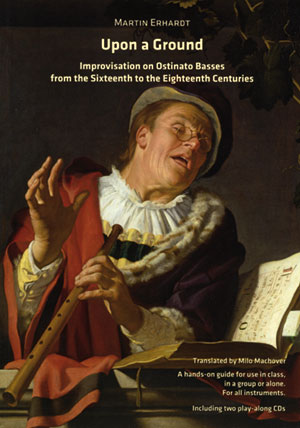Martin Erhardt: Upon a Ground
A book review
Martin Erhardt: Upon a Ground – Improvisation on Ostinato Basses from the Sixteenth to the Eighteenth Centuries. A Hands-on guide for use in class, in a group or alone. For all instruments, including two play-along CDs (in 415 and 440 Hz). Edition Wanhall, EW 905 (2014).
Usually, we are used to publish reviews of actual CDs and sheet music only in German within our printed version of Windkanal – the German recorder magazine.
But no rule without exception:
As now a translation of this instruction book about improvisation methods in early music has also appeared, and as we had reviewed the German text of this fine work in the printed issue of Windkanal 2013-4, we thought it is time to publish here an English translation of the review for our international readers.
Upon a Ground – Improvising on 16th to 18th Century Ground Basses
Musicians in the 16th to 18th centuries improvised regularly. How was this done? Martin Erhardt has provided an expert and easily accessible introduction to improvisation over ostinato bass lines from the 16th to 18th centuries.
A book review by Kirsten Christmann.
Improvisation and composition are usually considered to be at opposing ends of the spectrum of music performance and theory (at least within ‘classical’ music): there is the work created by a composer that a performing musician interprets in his own personal way, and there is improvisation, which gives the performing musician the opportunity to be creative and express his own musical ideas (depending on his technical and stylistic knowledge and ability). Martin Erhardt’s tutor book ‘Upon a Ground’ makes a plea for the study of the interaction between composition and improvisation, and is dedicated to musically experiencing these essential aspects of historically informed performance and improvisation practice.
In the first part of the book the author, in a systematic and historical overview, lists the most important forms that are based on an ostinato bass line. These are briefly explained and analysed, presenting exemplary compositions as models. Numerous music examples, using well-known as well as less familiar works, are used to explain to the reader the harmonic progressions of ground basses such as the Passamezzo, Bergamasca, Folia, Chaconne etc. This comprehensive collection helps to create a sense of how important ground basses were as a framework for the compositions of the period.
The second part is practical and provides a methodical introduction to stylistically aware improvisation. Progressing in small, easy steps, it begins with pendular ostinatos of seconds and fourths in the bass, and variations on simple bass models are worked through. Here the different formulae are discussed, applied, and then played in duple as well as in triple time. The exercises become gradually more complex, so that finally the student is able to accomplish modulations and improvisations in several parts. Apart from providing stylistic basics many general ideas on the subject of improvisation are incorporated into the instructions including musical parameters such as tension, affects and (error)-psychology. This book is well-structured, methodically clear and highly motivating. Finally, the reader is invited to participate in an extensive jam session on ostinato bass lines by way of a musically inspiring play-along CD.
(Translation: Ulli Burchette)



 English
English








